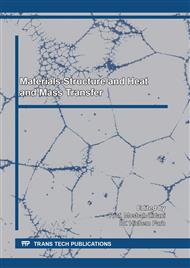[1]
M.C Diaz-Maroto, M.S Perez Coello, MD Cabezudo, Effect of differ drying methods on the volatile components of parsley (Petroselinum ispum L.), Eur. Food Res. Technol. 215 (2002) 227-230.
Google Scholar
[2]
A. Belghit, M. Kouhila, B.C. Boutaleb, Experimental study of drying kinetics by forced convection of aromatic plants. Energ. Convers. Manage. 41 (2000) 1303-1321.
DOI: 10.1016/s0196-8904(99)00162-4
Google Scholar
[3]
U. Siripatrawan, P. Jantawat, Determination of moisture sorption isotherms of jasmine rice crackers using BET and GAB models, Food Sci. Technol Int. 12 (2006) 459–465.
DOI: 10.1177/1082013206072622
Google Scholar
[4]
J.V. García-Pérez, J.A. Carcel, M.A. García-Alvadro, A. Mulet, Simulation of grape stalk deep-bed drying. J. Food Eng. 90 (2009) 308-314.
DOI: 10.1016/j.jfoodeng.2008.07.002
Google Scholar
[5]
E. Arranz, L. Jaime, M.C. Lopez de la Hazas, G. Vicente, G. Reglero, S. Santoyo, Supercritical sage extracts as anti-inflammatory food ingredients, Ind Crop Prod. 54 (2014) 159-166.
DOI: 10.1016/j.indcrop.2014.01.021
Google Scholar
[6]
B. Bozin, N. Mimica-Dukic, I. Samojlik, E. Jovin, Antimicrobial and antioxidant properties of rosemary and sage (Rosmarinus officinalis L. and Salvia officinalis L., Lamiaceae) essential oils, J Agric Food Chem. 55 (2007) 7879-7885.
DOI: 10.1021/jf0715323
Google Scholar
[7]
M.M. Ehrnhofer-Ressler, K. Fricke, M. Pignitter, J.M. Walker, J. Walker, M. Rychlik, V. Somoza, Identification of 1, 8-cineole, borneol, camphor, and thujone as anti-inflammatory compounds in a Salvia officinalis L. infusion using human gingival fibroblasts, J Agric Food Chem. 61 (2013) 3451–3459.
DOI: 10.1021/jf305472t
Google Scholar
[8]
L.F. DiCesare, E. Forni, D.Viscardi, R.C. Nani, Changes in the chemical composition of basil caused by different drying procedures, J. Agric. Food Chem. 51 (2003) 3575-3581.
DOI: 10.1021/jf021080o
Google Scholar
[9]
İ. Doymaz, S. Karasu, Effect of air temperature on drying kinetics, colour changes and total phenolic content of sage leaves (Salvia officinalis), Qual Assur Saf. Crops Foods. 10 (2018) 269-276.
DOI: 10.3920/qas2017.1257
Google Scholar
[10]
M. Jebri, H. Desmorieux, A. Maaloul, E. Saadaoui, M. Romdhane, Drying of Salvia officinalis L. by hot air and microwaves: dynamic desorption isotherms, drying kinetics and biochemical quality, Heat Mass Transfer. 55 (2018) 1143-1153.
DOI: 10.1007/s00231-018-2498-9
Google Scholar
[11]
O. Bensebia, K. Allia, Analysis of adsorption–desorption moisture isotherms of rosemary leaves, J. Appl Res. Med Aroma Plants. 3 (2016) 79–86.
DOI: 10.1016/j.jarmap.2016.01.005
Google Scholar
[12]
C.J. Lomauro, A.S. Bakshi, T.P. Labuza, Evaluation of food moisture sorption isotherm equations. Part I. Fruit: Vegetable and Meat Products, LWT-Food Sci. Technol. 18 (1985) 111–117.
Google Scholar
[13]
S. Yanniotis, J. Blahovec, Model analysis of sorption isotherms, LWT-Food Sci. Technol. 42 (2009) 1688–1695.
DOI: 10.1016/j.lwt.2009.05.010
Google Scholar
[14]
E.Tsami, Net isosteric heat of sorption in dried fruits, J. Food Eng. 14 (1991) 327–335.
DOI: 10.1016/0260-8774(91)90022-k
Google Scholar
[15]
A. Arabhossein, W. Huisman, A.Van Boxtel, J.Müller, Modeling of thin layer drying of tarragon (Artemisia dracuncuhus L.), Ind Crops Prod. 29 (2009) 53-59.
DOI: 10.1016/j.indcrop.2008.04.005
Google Scholar
[16]
I. Doymaz, Thin layer drying behaviour of mint leaves, J. Food Eng., 74 (2006) 370-375.
DOI: 10.1016/j.jfoodeng.2005.03.009
Google Scholar
[17]
M. Ozdemir, Y.O Devers, The thin layer drying characteristics of hazelnuts during roasting, J. Food Eng. 42 (1999) 225-233.
DOI: 10.1016/s0260-8774(99)00126-0
Google Scholar
[18]
J. Cranck, The mathematics of diffusion, second ed., Oxford, UK. Clarendon Press, (1975).
Google Scholar
[19]
C.S. Ethmane Kane, M. Kouhila, A. Lamharrar, A. Idlimam, A. Mimet, Moisture sorption isotherms and thermodynamic properties of two mints: Mentha pulegium and Mentha roundifolia, Revue des Energies Renouvelables. 11 (2008) 181-195.
DOI: 10.3923/ja.2008.1.14
Google Scholar
[20]
H. Machhour, A. Idlimam, M. Mahrouz, I. El Hadrami , M. Kouhila, Sorption isotherms and thermodynamic properties of peppermint tea (Mentha piperita) after thermal and biochemical treatment, J. Mater. Environ. Sci. 3 (2012) 232-247.
Google Scholar
[21]
S. Cenkowski, D.S. Jayas, D. Hao, Latent heat of vaporization for selected foods and crops, Can. Agric. Eng. 34 (1992) 281–286.
Google Scholar
[22]
K.J. Park, Z. Vohnikova, F.P.R. Brad, Evaluation of drying parameters and desorption isotherms of garden mint leaves (Mentha crispa L.), J. Food Eng. 51 (2002) 193-199.
DOI: 10.1016/s0260-8774(01)00055-3
Google Scholar
[23]
O. Bensebia, K. Allia, Drying and Extraction Kinetics of Rosemary Leaves: Experiments and Modeling, J. Essent Oil Bear Plants. 18 (2015) 99-111.
DOI: 10.1080/0972060x.2014.901620
Google Scholar
[24]
A. Kaya, O. Aydin, An experimental study on drying kinetics of some herbal leaves. Energ. Convers. Manage. 50 (2009) 118-124.
Google Scholar


